Health advancement and promotion Assignment
VerifiedAdded on 2021/06/15
|7
|1706
|28
AI Summary
Contribute Materials
Your contribution can guide someone’s learning journey. Share your
documents today.
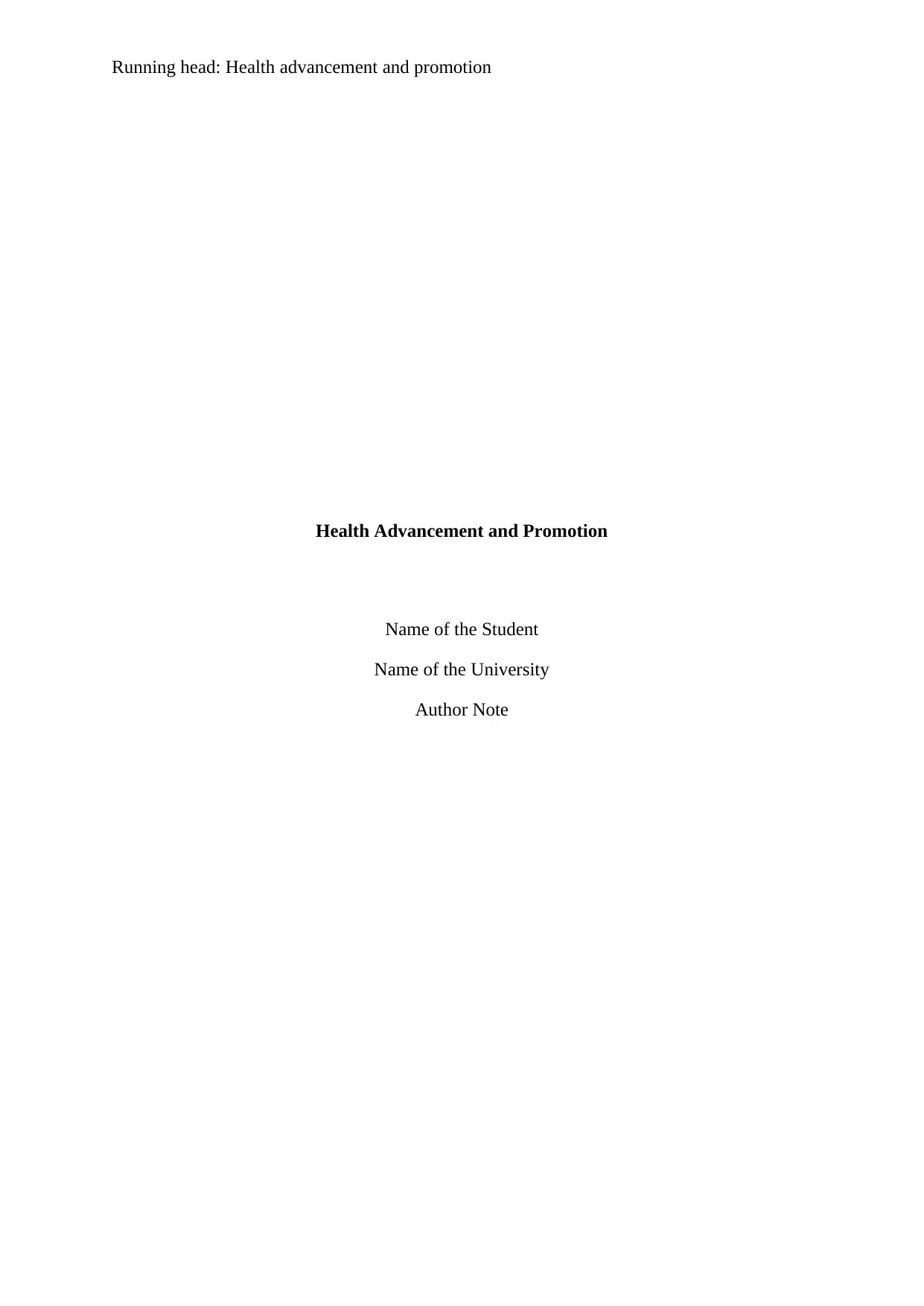
Running head: Health advancement and promotion
Health Advancement and Promotion
Name of the Student
Name of the University
Author Note
Health Advancement and Promotion
Name of the Student
Name of the University
Author Note
Secure Best Marks with AI Grader
Need help grading? Try our AI Grader for instant feedback on your assignments.
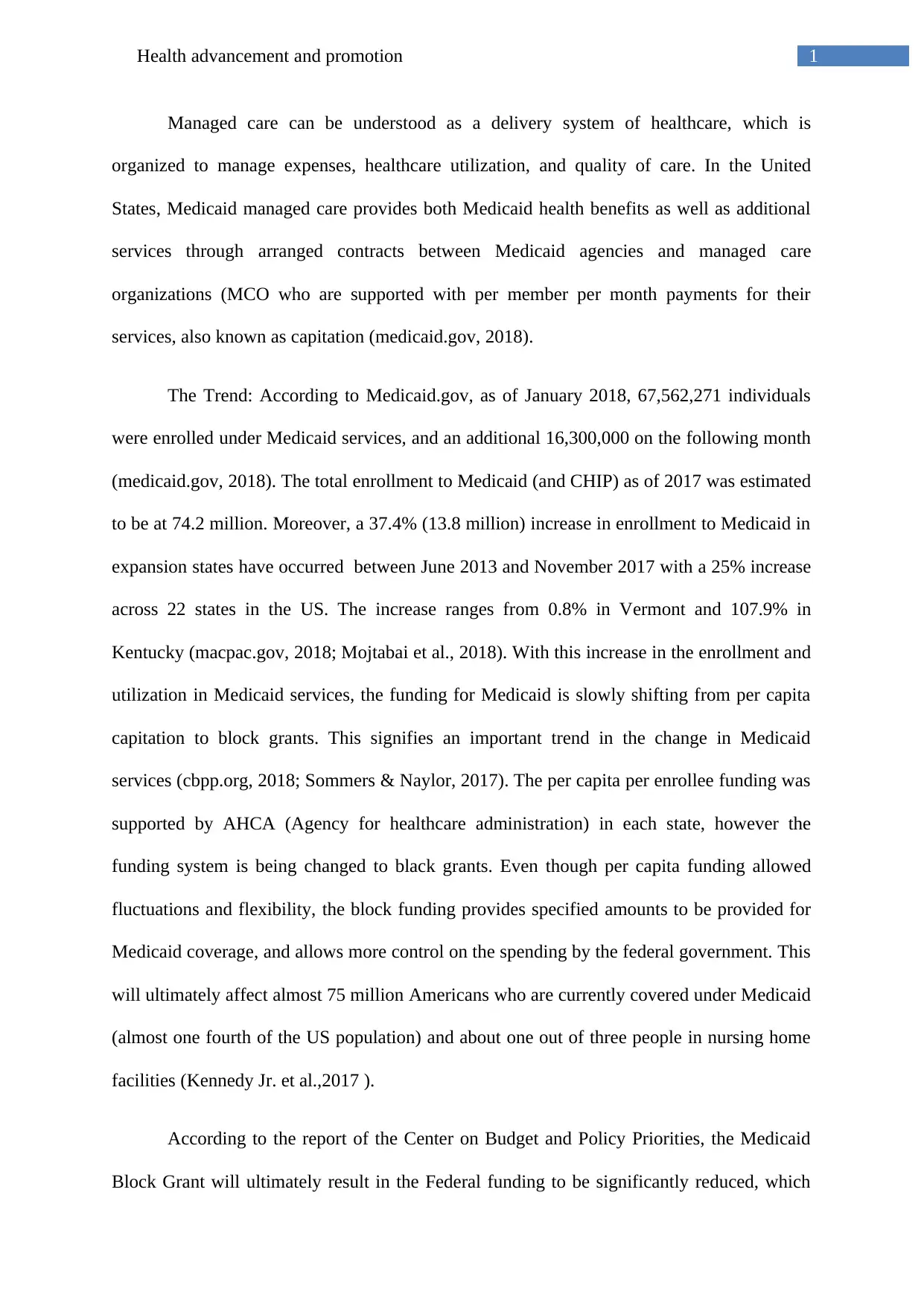
1Health advancement and promotion
Managed care can be understood as a delivery system of healthcare, which is
organized to manage expenses, healthcare utilization, and quality of care. In the United
States, Medicaid managed care provides both Medicaid health benefits as well as additional
services through arranged contracts between Medicaid agencies and managed care
organizations (MCO who are supported with per member per month payments for their
services, also known as capitation (medicaid.gov, 2018).
The Trend: According to Medicaid.gov, as of January 2018, 67,562,271 individuals
were enrolled under Medicaid services, and an additional 16,300,000 on the following month
(medicaid.gov, 2018). The total enrollment to Medicaid (and CHIP) as of 2017 was estimated
to be at 74.2 million. Moreover, a 37.4% (13.8 million) increase in enrollment to Medicaid in
expansion states have occurred between June 2013 and November 2017 with a 25% increase
across 22 states in the US. The increase ranges from 0.8% in Vermont and 107.9% in
Kentucky (macpac.gov, 2018; Mojtabai et al., 2018). With this increase in the enrollment and
utilization in Medicaid services, the funding for Medicaid is slowly shifting from per capita
capitation to block grants. This signifies an important trend in the change in Medicaid
services (cbpp.org, 2018; Sommers & Naylor, 2017). The per capita per enrollee funding was
supported by AHCA (Agency for healthcare administration) in each state, however the
funding system is being changed to black grants. Even though per capita funding allowed
fluctuations and flexibility, the block funding provides specified amounts to be provided for
Medicaid coverage, and allows more control on the spending by the federal government. This
will ultimately affect almost 75 million Americans who are currently covered under Medicaid
(almost one fourth of the US population) and about one out of three people in nursing home
facilities (Kennedy Jr. et al.,2017 ).
According to the report of the Center on Budget and Policy Priorities, the Medicaid
Block Grant will ultimately result in the Federal funding to be significantly reduced, which
Managed care can be understood as a delivery system of healthcare, which is
organized to manage expenses, healthcare utilization, and quality of care. In the United
States, Medicaid managed care provides both Medicaid health benefits as well as additional
services through arranged contracts between Medicaid agencies and managed care
organizations (MCO who are supported with per member per month payments for their
services, also known as capitation (medicaid.gov, 2018).
The Trend: According to Medicaid.gov, as of January 2018, 67,562,271 individuals
were enrolled under Medicaid services, and an additional 16,300,000 on the following month
(medicaid.gov, 2018). The total enrollment to Medicaid (and CHIP) as of 2017 was estimated
to be at 74.2 million. Moreover, a 37.4% (13.8 million) increase in enrollment to Medicaid in
expansion states have occurred between June 2013 and November 2017 with a 25% increase
across 22 states in the US. The increase ranges from 0.8% in Vermont and 107.9% in
Kentucky (macpac.gov, 2018; Mojtabai et al., 2018). With this increase in the enrollment and
utilization in Medicaid services, the funding for Medicaid is slowly shifting from per capita
capitation to block grants. This signifies an important trend in the change in Medicaid
services (cbpp.org, 2018; Sommers & Naylor, 2017). The per capita per enrollee funding was
supported by AHCA (Agency for healthcare administration) in each state, however the
funding system is being changed to black grants. Even though per capita funding allowed
fluctuations and flexibility, the block funding provides specified amounts to be provided for
Medicaid coverage, and allows more control on the spending by the federal government. This
will ultimately affect almost 75 million Americans who are currently covered under Medicaid
(almost one fourth of the US population) and about one out of three people in nursing home
facilities (Kennedy Jr. et al.,2017 ).
According to the report of the Center on Budget and Policy Priorities, the Medicaid
Block Grant will ultimately result in the Federal funding to be significantly reduced, which
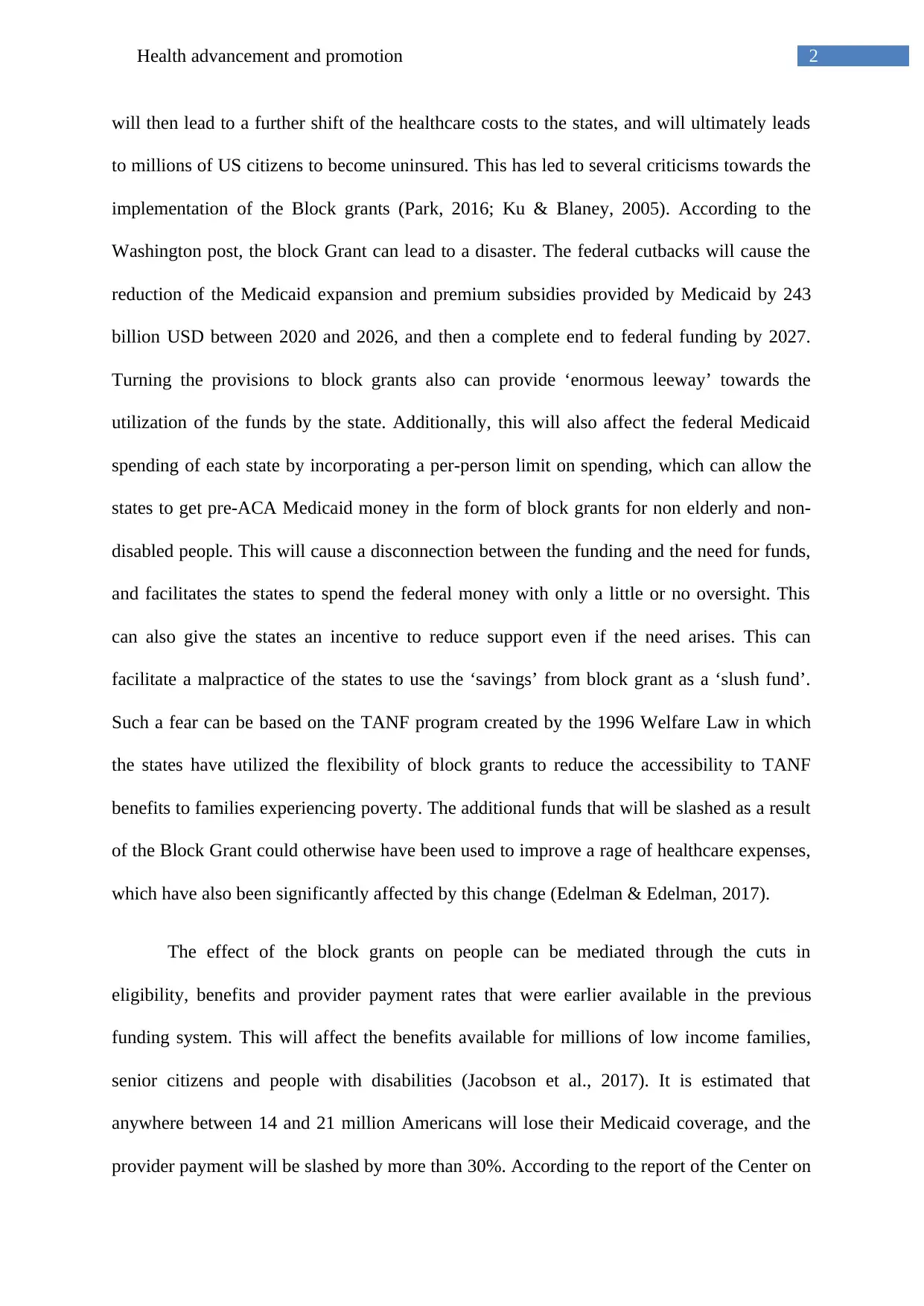
2Health advancement and promotion
will then lead to a further shift of the healthcare costs to the states, and will ultimately leads
to millions of US citizens to become uninsured. This has led to several criticisms towards the
implementation of the Block grants (Park, 2016; Ku & Blaney, 2005). According to the
Washington post, the block Grant can lead to a disaster. The federal cutbacks will cause the
reduction of the Medicaid expansion and premium subsidies provided by Medicaid by 243
billion USD between 2020 and 2026, and then a complete end to federal funding by 2027.
Turning the provisions to block grants also can provide ‘enormous leeway’ towards the
utilization of the funds by the state. Additionally, this will also affect the federal Medicaid
spending of each state by incorporating a per-person limit on spending, which can allow the
states to get pre-ACA Medicaid money in the form of block grants for non elderly and non-
disabled people. This will cause a disconnection between the funding and the need for funds,
and facilitates the states to spend the federal money with only a little or no oversight. This
can also give the states an incentive to reduce support even if the need arises. This can
facilitate a malpractice of the states to use the ‘savings’ from block grant as a ‘slush fund’.
Such a fear can be based on the TANF program created by the 1996 Welfare Law in which
the states have utilized the flexibility of block grants to reduce the accessibility to TANF
benefits to families experiencing poverty. The additional funds that will be slashed as a result
of the Block Grant could otherwise have been used to improve a rage of healthcare expenses,
which have also been significantly affected by this change (Edelman & Edelman, 2017).
The effect of the block grants on people can be mediated through the cuts in
eligibility, benefits and provider payment rates that were earlier available in the previous
funding system. This will affect the benefits available for millions of low income families,
senior citizens and people with disabilities (Jacobson et al., 2017). It is estimated that
anywhere between 14 and 21 million Americans will lose their Medicaid coverage, and the
provider payment will be slashed by more than 30%. According to the report of the Center on
will then lead to a further shift of the healthcare costs to the states, and will ultimately leads
to millions of US citizens to become uninsured. This has led to several criticisms towards the
implementation of the Block grants (Park, 2016; Ku & Blaney, 2005). According to the
Washington post, the block Grant can lead to a disaster. The federal cutbacks will cause the
reduction of the Medicaid expansion and premium subsidies provided by Medicaid by 243
billion USD between 2020 and 2026, and then a complete end to federal funding by 2027.
Turning the provisions to block grants also can provide ‘enormous leeway’ towards the
utilization of the funds by the state. Additionally, this will also affect the federal Medicaid
spending of each state by incorporating a per-person limit on spending, which can allow the
states to get pre-ACA Medicaid money in the form of block grants for non elderly and non-
disabled people. This will cause a disconnection between the funding and the need for funds,
and facilitates the states to spend the federal money with only a little or no oversight. This
can also give the states an incentive to reduce support even if the need arises. This can
facilitate a malpractice of the states to use the ‘savings’ from block grant as a ‘slush fund’.
Such a fear can be based on the TANF program created by the 1996 Welfare Law in which
the states have utilized the flexibility of block grants to reduce the accessibility to TANF
benefits to families experiencing poverty. The additional funds that will be slashed as a result
of the Block Grant could otherwise have been used to improve a rage of healthcare expenses,
which have also been significantly affected by this change (Edelman & Edelman, 2017).
The effect of the block grants on people can be mediated through the cuts in
eligibility, benefits and provider payment rates that were earlier available in the previous
funding system. This will affect the benefits available for millions of low income families,
senior citizens and people with disabilities (Jacobson et al., 2017). It is estimated that
anywhere between 14 and 21 million Americans will lose their Medicaid coverage, and the
provider payment will be slashed by more than 30%. According to the report of the Center on
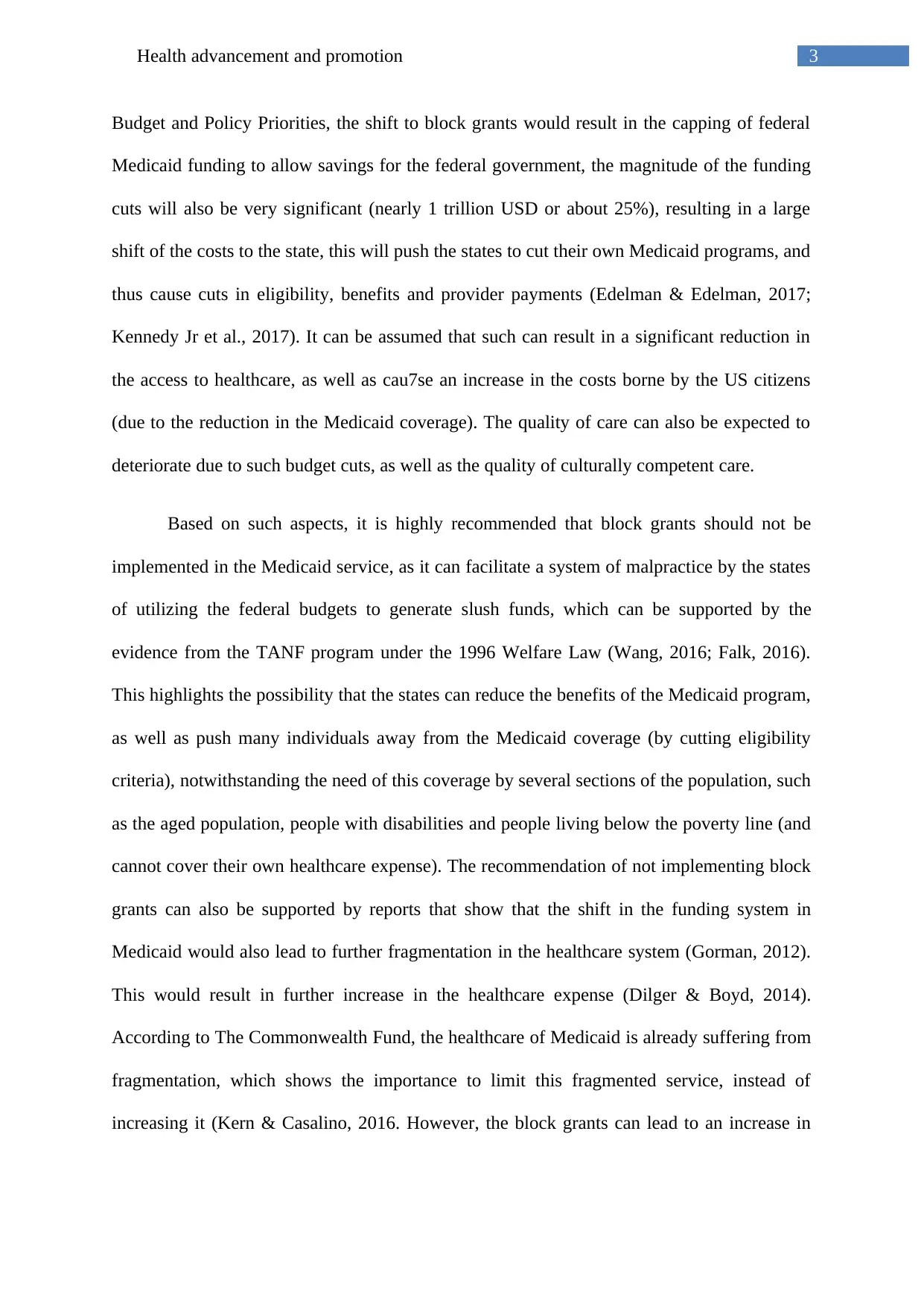
3Health advancement and promotion
Budget and Policy Priorities, the shift to block grants would result in the capping of federal
Medicaid funding to allow savings for the federal government, the magnitude of the funding
cuts will also be very significant (nearly 1 trillion USD or about 25%), resulting in a large
shift of the costs to the state, this will push the states to cut their own Medicaid programs, and
thus cause cuts in eligibility, benefits and provider payments (Edelman & Edelman, 2017;
Kennedy Jr et al., 2017). It can be assumed that such can result in a significant reduction in
the access to healthcare, as well as cau7se an increase in the costs borne by the US citizens
(due to the reduction in the Medicaid coverage). The quality of care can also be expected to
deteriorate due to such budget cuts, as well as the quality of culturally competent care.
Based on such aspects, it is highly recommended that block grants should not be
implemented in the Medicaid service, as it can facilitate a system of malpractice by the states
of utilizing the federal budgets to generate slush funds, which can be supported by the
evidence from the TANF program under the 1996 Welfare Law (Wang, 2016; Falk, 2016).
This highlights the possibility that the states can reduce the benefits of the Medicaid program,
as well as push many individuals away from the Medicaid coverage (by cutting eligibility
criteria), notwithstanding the need of this coverage by several sections of the population, such
as the aged population, people with disabilities and people living below the poverty line (and
cannot cover their own healthcare expense). The recommendation of not implementing block
grants can also be supported by reports that show that the shift in the funding system in
Medicaid would also lead to further fragmentation in the healthcare system (Gorman, 2012).
This would result in further increase in the healthcare expense (Dilger & Boyd, 2014).
According to The Commonwealth Fund, the healthcare of Medicaid is already suffering from
fragmentation, which shows the importance to limit this fragmented service, instead of
increasing it (Kern & Casalino, 2016. However, the block grants can lead to an increase in
Budget and Policy Priorities, the shift to block grants would result in the capping of federal
Medicaid funding to allow savings for the federal government, the magnitude of the funding
cuts will also be very significant (nearly 1 trillion USD or about 25%), resulting in a large
shift of the costs to the state, this will push the states to cut their own Medicaid programs, and
thus cause cuts in eligibility, benefits and provider payments (Edelman & Edelman, 2017;
Kennedy Jr et al., 2017). It can be assumed that such can result in a significant reduction in
the access to healthcare, as well as cau7se an increase in the costs borne by the US citizens
(due to the reduction in the Medicaid coverage). The quality of care can also be expected to
deteriorate due to such budget cuts, as well as the quality of culturally competent care.
Based on such aspects, it is highly recommended that block grants should not be
implemented in the Medicaid service, as it can facilitate a system of malpractice by the states
of utilizing the federal budgets to generate slush funds, which can be supported by the
evidence from the TANF program under the 1996 Welfare Law (Wang, 2016; Falk, 2016).
This highlights the possibility that the states can reduce the benefits of the Medicaid program,
as well as push many individuals away from the Medicaid coverage (by cutting eligibility
criteria), notwithstanding the need of this coverage by several sections of the population, such
as the aged population, people with disabilities and people living below the poverty line (and
cannot cover their own healthcare expense). The recommendation of not implementing block
grants can also be supported by reports that show that the shift in the funding system in
Medicaid would also lead to further fragmentation in the healthcare system (Gorman, 2012).
This would result in further increase in the healthcare expense (Dilger & Boyd, 2014).
According to The Commonwealth Fund, the healthcare of Medicaid is already suffering from
fragmentation, which shows the importance to limit this fragmented service, instead of
increasing it (Kern & Casalino, 2016. However, the block grants can lead to an increase in
Secure Best Marks with AI Grader
Need help grading? Try our AI Grader for instant feedback on your assignments.

4Health advancement and promotion
fragmentation. This it is highly recommended that such change in funding system should not
be implemented.
fragmentation. This it is highly recommended that such change in funding system should not
be implemented.
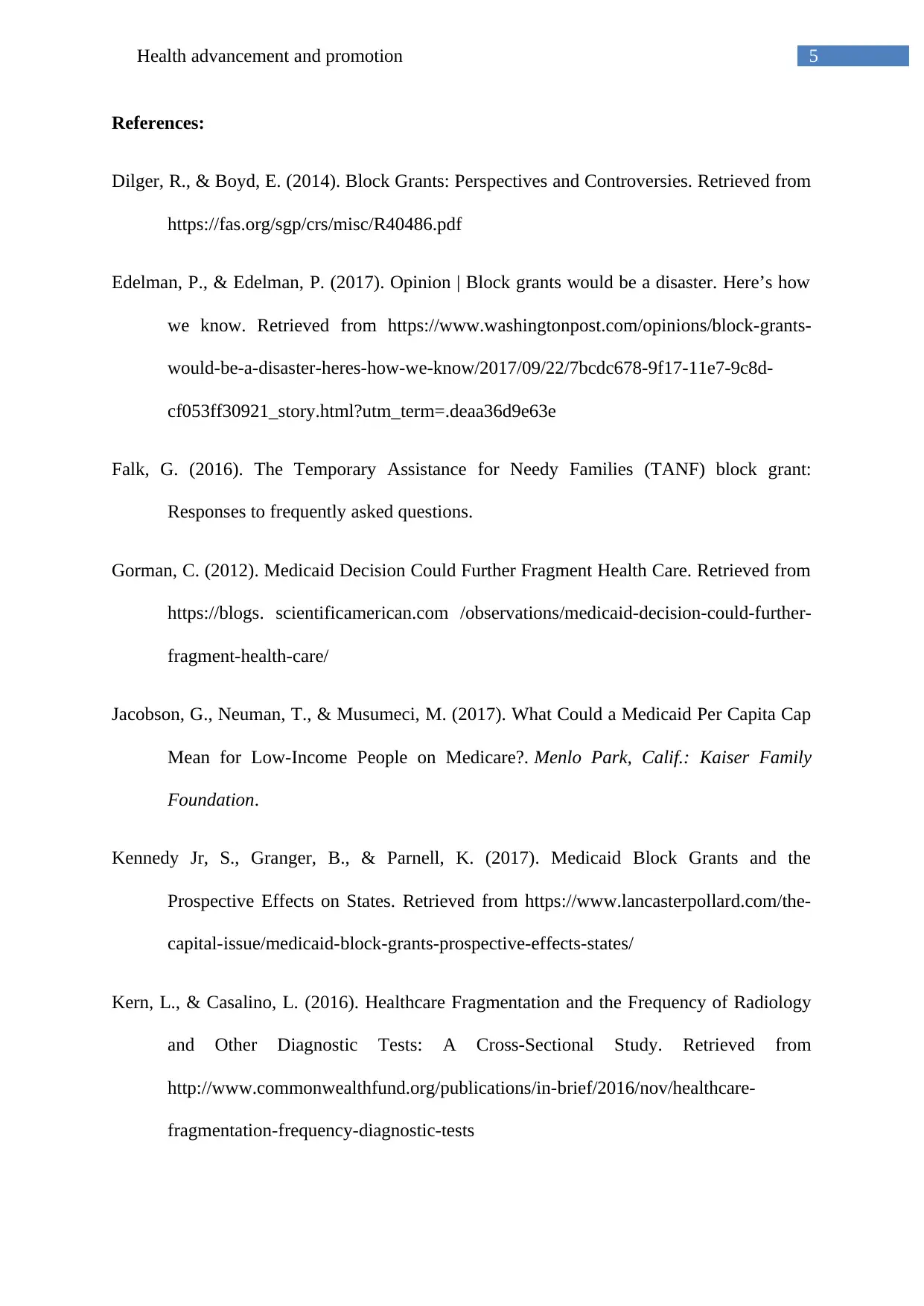
5Health advancement and promotion
References:
Dilger, R., & Boyd, E. (2014). Block Grants: Perspectives and Controversies. Retrieved from
https://fas.org/sgp/crs/misc/R40486.pdf
Edelman, P., & Edelman, P. (2017). Opinion | Block grants would be a disaster. Here’s how
we know. Retrieved from https://www.washingtonpost.com/opinions/block-grants-
would-be-a-disaster-heres-how-we-know/2017/09/22/7bcdc678-9f17-11e7-9c8d-
cf053ff30921_story.html?utm_term=.deaa36d9e63e
Falk, G. (2016). The Temporary Assistance for Needy Families (TANF) block grant:
Responses to frequently asked questions.
Gorman, C. (2012). Medicaid Decision Could Further Fragment Health Care. Retrieved from
https://blogs. scientificamerican.com /observations/medicaid-decision-could-further-
fragment-health-care/
Jacobson, G., Neuman, T., & Musumeci, M. (2017). What Could a Medicaid Per Capita Cap
Mean for Low-Income People on Medicare?. Menlo Park, Calif.: Kaiser Family
Foundation.
Kennedy Jr, S., Granger, B., & Parnell, K. (2017). Medicaid Block Grants and the
Prospective Effects on States. Retrieved from https://www.lancasterpollard.com/the-
capital-issue/medicaid-block-grants-prospective-effects-states/
Kern, L., & Casalino, L. (2016). Healthcare Fragmentation and the Frequency of Radiology
and Other Diagnostic Tests: A Cross-Sectional Study. Retrieved from
http://www.commonwealthfund.org/publications/in-brief/2016/nov/healthcare-
fragmentation-frequency-diagnostic-tests
References:
Dilger, R., & Boyd, E. (2014). Block Grants: Perspectives and Controversies. Retrieved from
https://fas.org/sgp/crs/misc/R40486.pdf
Edelman, P., & Edelman, P. (2017). Opinion | Block grants would be a disaster. Here’s how
we know. Retrieved from https://www.washingtonpost.com/opinions/block-grants-
would-be-a-disaster-heres-how-we-know/2017/09/22/7bcdc678-9f17-11e7-9c8d-
cf053ff30921_story.html?utm_term=.deaa36d9e63e
Falk, G. (2016). The Temporary Assistance for Needy Families (TANF) block grant:
Responses to frequently asked questions.
Gorman, C. (2012). Medicaid Decision Could Further Fragment Health Care. Retrieved from
https://blogs. scientificamerican.com /observations/medicaid-decision-could-further-
fragment-health-care/
Jacobson, G., Neuman, T., & Musumeci, M. (2017). What Could a Medicaid Per Capita Cap
Mean for Low-Income People on Medicare?. Menlo Park, Calif.: Kaiser Family
Foundation.
Kennedy Jr, S., Granger, B., & Parnell, K. (2017). Medicaid Block Grants and the
Prospective Effects on States. Retrieved from https://www.lancasterpollard.com/the-
capital-issue/medicaid-block-grants-prospective-effects-states/
Kern, L., & Casalino, L. (2016). Healthcare Fragmentation and the Frequency of Radiology
and Other Diagnostic Tests: A Cross-Sectional Study. Retrieved from
http://www.commonwealthfund.org/publications/in-brief/2016/nov/healthcare-
fragmentation-frequency-diagnostic-tests
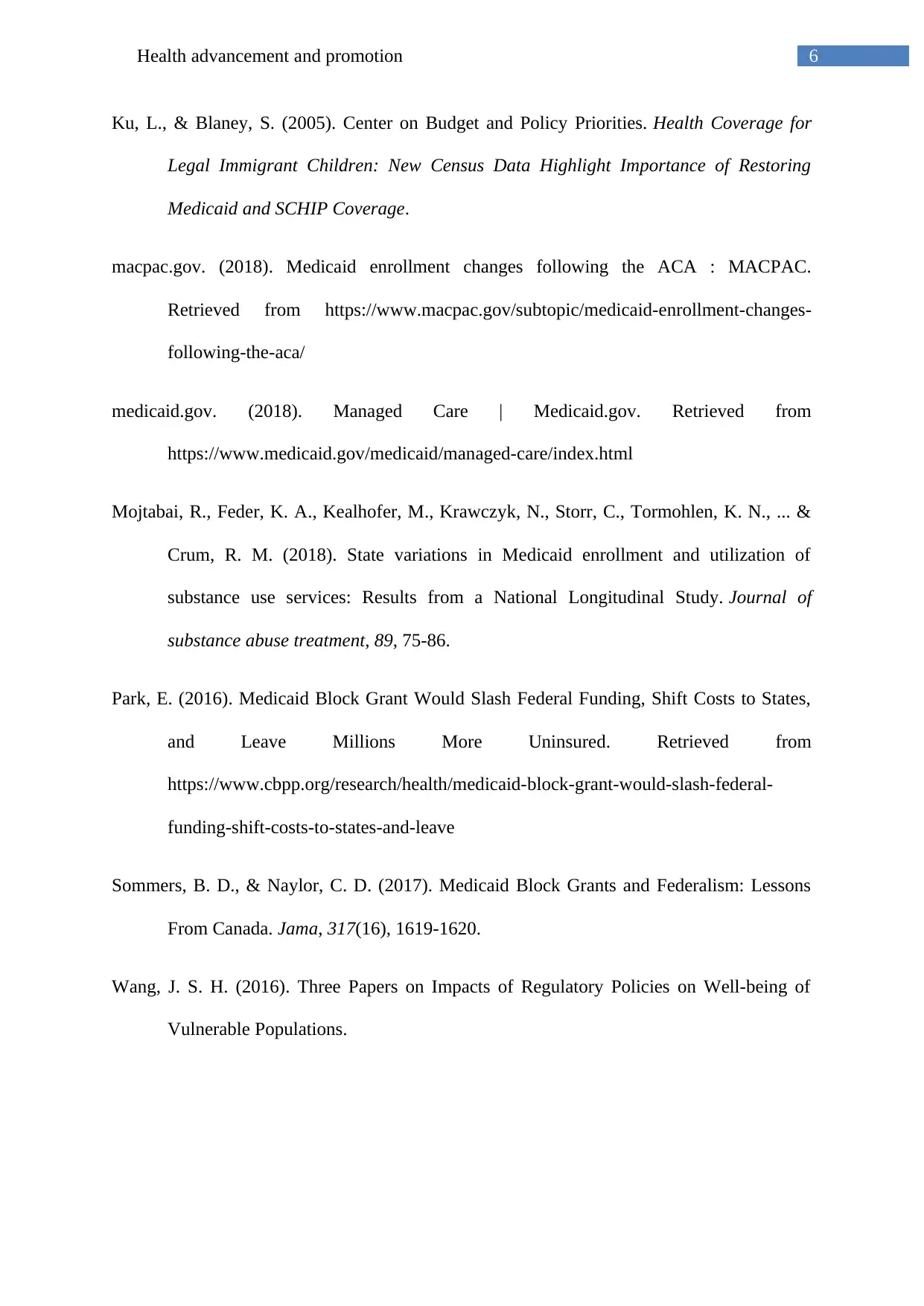
6Health advancement and promotion
Ku, L., & Blaney, S. (2005). Center on Budget and Policy Priorities. Health Coverage for
Legal Immigrant Children: New Census Data Highlight Importance of Restoring
Medicaid and SCHIP Coverage.
macpac.gov. (2018). Medicaid enrollment changes following the ACA : MACPAC.
Retrieved from https://www.macpac.gov/subtopic/medicaid-enrollment-changes-
following-the-aca/
medicaid.gov. (2018). Managed Care | Medicaid.gov. Retrieved from
https://www.medicaid.gov/medicaid/managed-care/index.html
Mojtabai, R., Feder, K. A., Kealhofer, M., Krawczyk, N., Storr, C., Tormohlen, K. N., ... &
Crum, R. M. (2018). State variations in Medicaid enrollment and utilization of
substance use services: Results from a National Longitudinal Study. Journal of
substance abuse treatment, 89, 75-86.
Park, E. (2016). Medicaid Block Grant Would Slash Federal Funding, Shift Costs to States,
and Leave Millions More Uninsured. Retrieved from
https://www.cbpp.org/research/health/medicaid-block-grant-would-slash-federal-
funding-shift-costs-to-states-and-leave
Sommers, B. D., & Naylor, C. D. (2017). Medicaid Block Grants and Federalism: Lessons
From Canada. Jama, 317(16), 1619-1620.
Wang, J. S. H. (2016). Three Papers on Impacts of Regulatory Policies on Well-being of
Vulnerable Populations.
Ku, L., & Blaney, S. (2005). Center on Budget and Policy Priorities. Health Coverage for
Legal Immigrant Children: New Census Data Highlight Importance of Restoring
Medicaid and SCHIP Coverage.
macpac.gov. (2018). Medicaid enrollment changes following the ACA : MACPAC.
Retrieved from https://www.macpac.gov/subtopic/medicaid-enrollment-changes-
following-the-aca/
medicaid.gov. (2018). Managed Care | Medicaid.gov. Retrieved from
https://www.medicaid.gov/medicaid/managed-care/index.html
Mojtabai, R., Feder, K. A., Kealhofer, M., Krawczyk, N., Storr, C., Tormohlen, K. N., ... &
Crum, R. M. (2018). State variations in Medicaid enrollment and utilization of
substance use services: Results from a National Longitudinal Study. Journal of
substance abuse treatment, 89, 75-86.
Park, E. (2016). Medicaid Block Grant Would Slash Federal Funding, Shift Costs to States,
and Leave Millions More Uninsured. Retrieved from
https://www.cbpp.org/research/health/medicaid-block-grant-would-slash-federal-
funding-shift-costs-to-states-and-leave
Sommers, B. D., & Naylor, C. D. (2017). Medicaid Block Grants and Federalism: Lessons
From Canada. Jama, 317(16), 1619-1620.
Wang, J. S. H. (2016). Three Papers on Impacts of Regulatory Policies on Well-being of
Vulnerable Populations.
1 out of 7
Related Documents
Your All-in-One AI-Powered Toolkit for Academic Success.
+13062052269
info@desklib.com
Available 24*7 on WhatsApp / Email
![[object Object]](/_next/static/media/star-bottom.7253800d.svg)
Unlock your academic potential
© 2024 | Zucol Services PVT LTD | All rights reserved.




